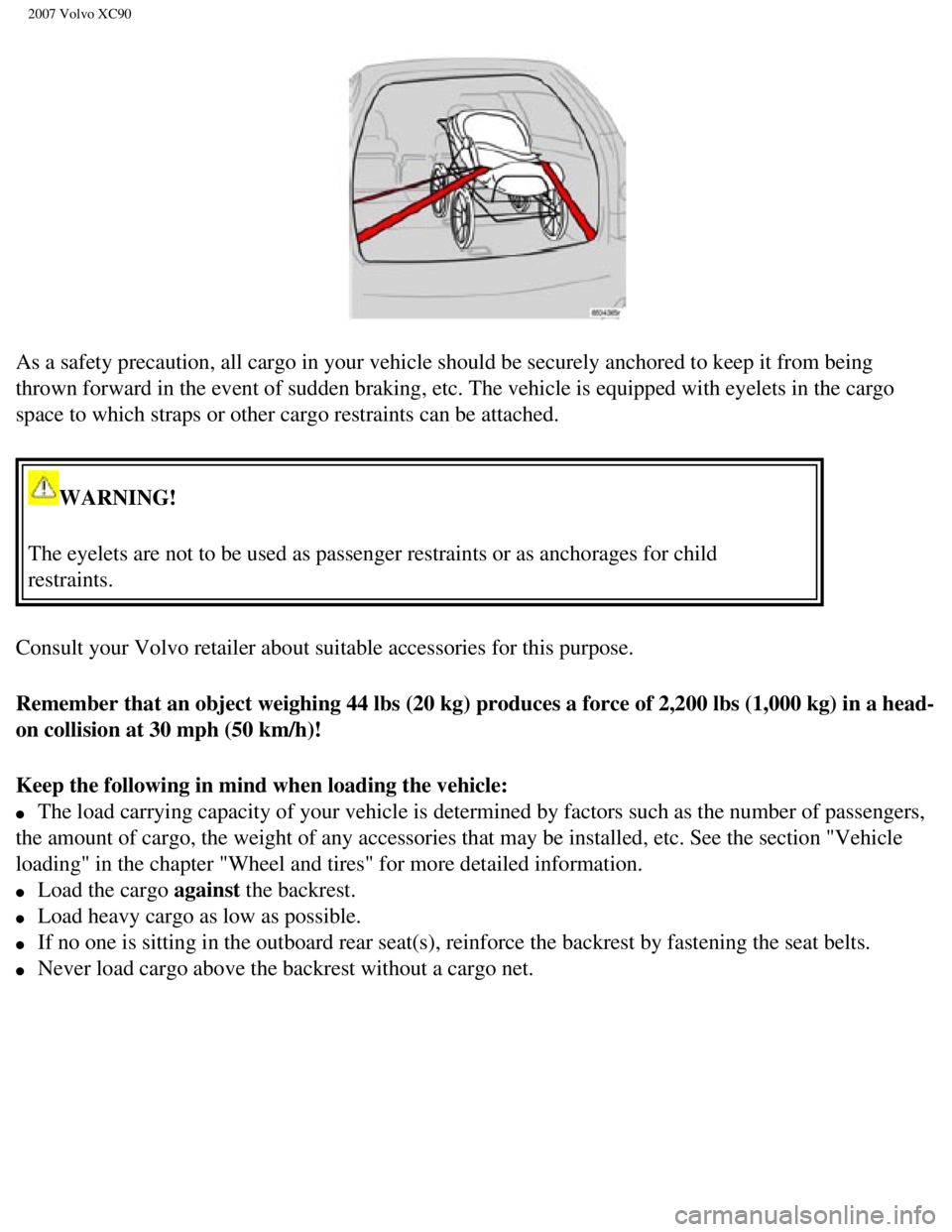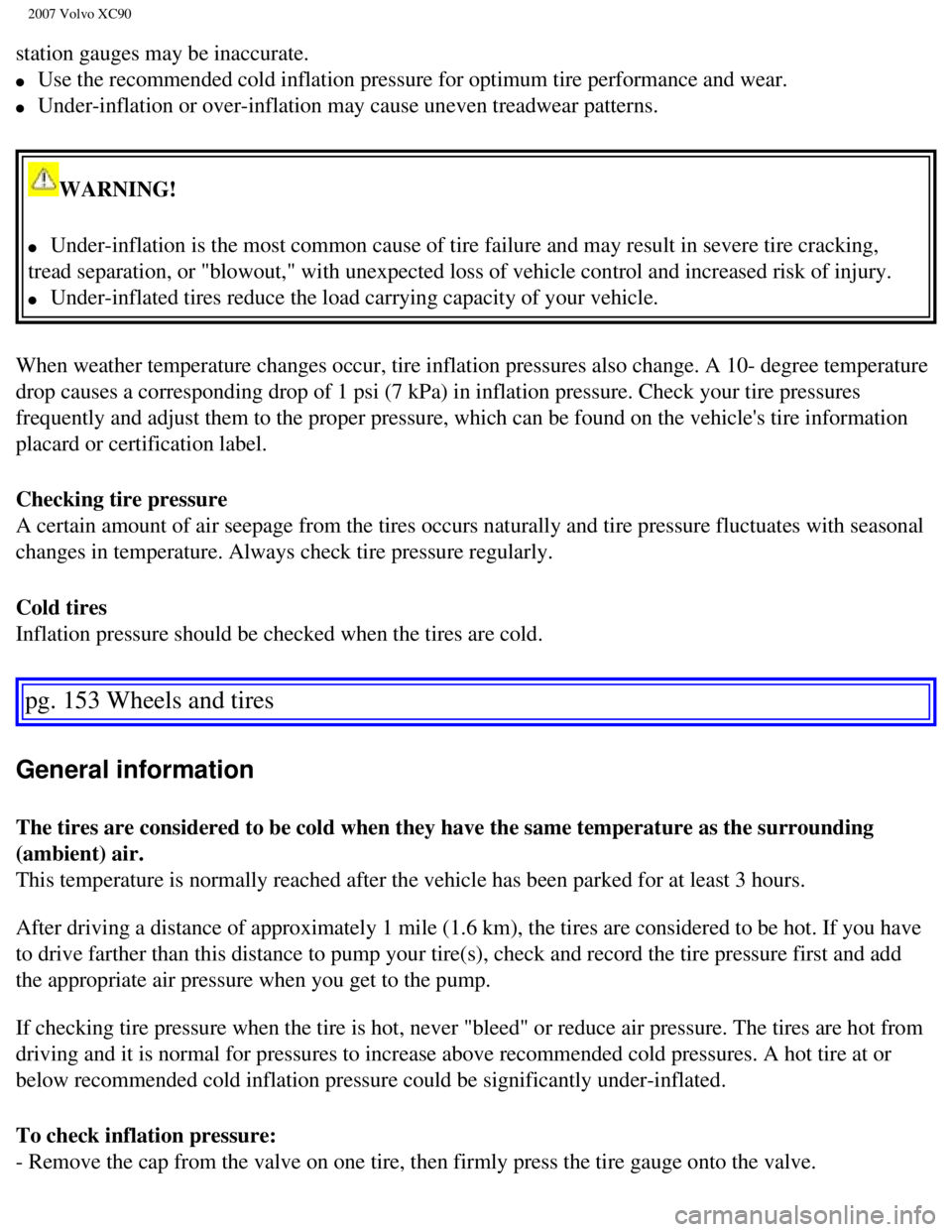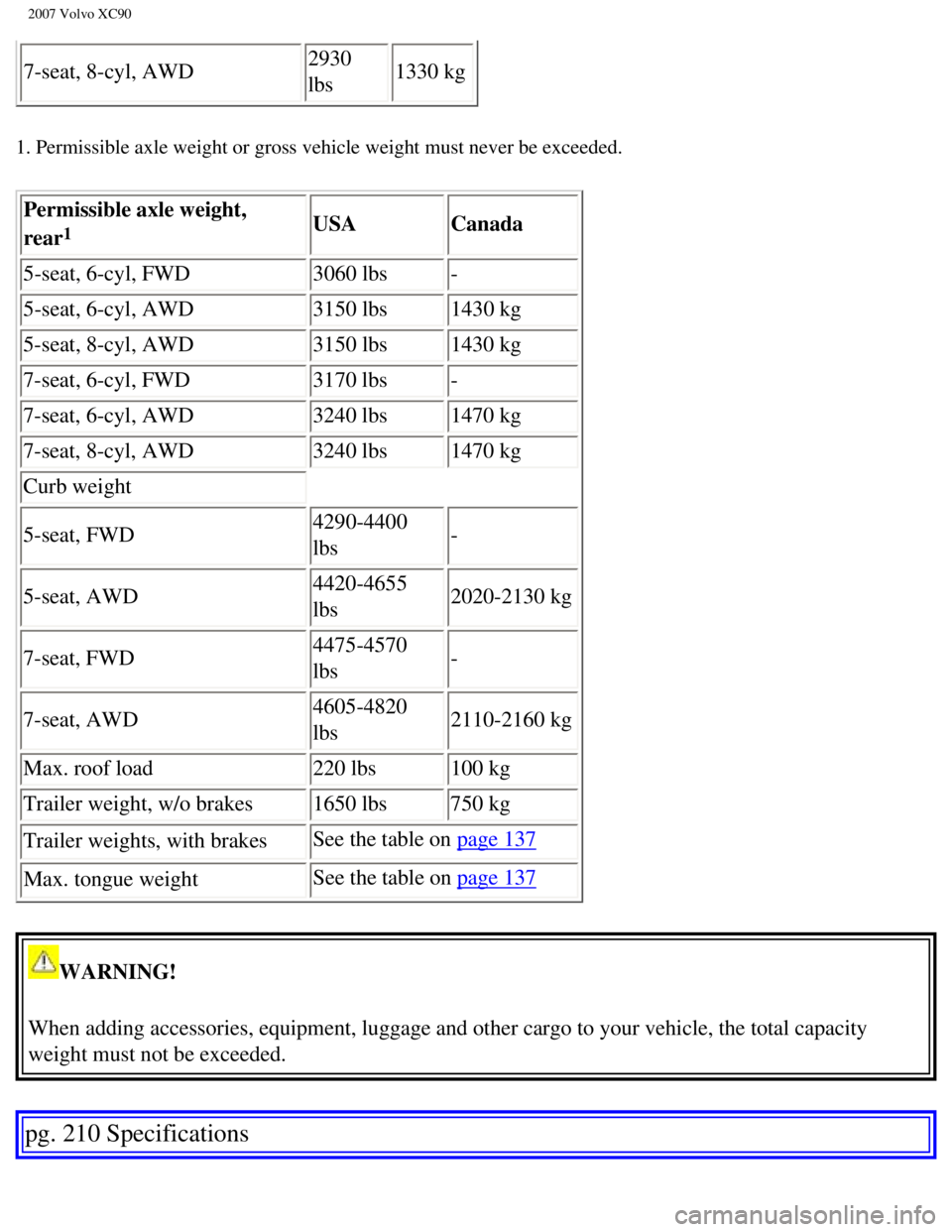2007 VOLVO XC90 load capacity
[x] Cancel search: load capacityPage 111 of 268

2007 Volvo XC90
As a safety precaution, all cargo in your vehicle should be securely anc\
hored to keep it from being
thrown forward in the event of sudden braking, etc. The vehicle is equip\
ped with eyelets in the cargo
space to which straps or other cargo restraints can be attached.
WARNING!
The eyelets are not to be used as passenger restraints or as anchorages \
for child
restraints.
Consult your Volvo retailer about suitable accessories for this purpose.\
Remember that an object weighing 44 lbs (20 kg) produces a force of 2,\
200 lbs (1,000 kg) in a head-
on collision at 30 mph (50 km/h)!
Keep the following in mind when loading the vehicle:
l The load carrying capacity of your vehicle is determined by factors such\
as the number of passengers,
the amount of cargo, the weight of any accessories that may be installed\
, etc. See the section "Vehicle
loading" in the chapter "Wheel and tires" for more detailed information.\
l Load the cargo against the backrest.
l Load heavy cargo as low as possible.
l If no one is sitting in the outboard rear seat(s), reinforce the backr\
est by fastening the seat belts.
l Never load cargo above the backrest without a cargo net.
file:///K|/ownersdocs/2007/2007_XC90/07xc90_04.htm (17 of 23)12/30/200\
6 5:53:40 PM
Page 128 of 268

2007 Volvo XC90
WARNING!
Carbon monoxide is a poisonous, colorless, and odorless gas. It is prese\
nt in all exhaust gases. If you ever smell exhaust
fumes inside the vehicle, make sure the passenger compartment is ventila\
ted, and immediately return the vehicle to your
retailer for correction.
pg. 116 Starting and driving
Fuel requirements
WARNING!
Driving with the tailgate open: Driving with the tailgate open could lead to poisonous exhaust gases e\
ntering the
passenger compartment. If the tailgate must be kept open for any reason,\
proceed as follows:
l Close the windows
l Set the ventilation system control to air flow to floor, windshield and \
side windows and blower control to its highest
setting.
Weight distribution affects handling
At the specified curb weight your vehicle has a tendency to understeer, \
which means that the steering wheel has to be
turned more than might seem appropriate for the curvature of a bend. Thi\
s ensures good stability and reduces the risk of
rear wheel skid. Remember that these properties can alter with the vehic\
le load. The heavier the load in the cargo area, the
less the tendency to understeer.
Handling, roadholding
Vehicle load, tire design and inflation pressure all affect vehicle hand\
ling. Therefore, check that the tires are inflated to the
recommended pressure according to the vehicle load. See "Tire pressure" \
section. Loads should be distributed so that
capacity weight or maximum permissible axle loads are not exceeded.
Conserving electrical current
Keep the following in mind to help minimize battery drain:
l When the engine is not running, avoid turning the ignition key to positi\
on II (see page 121). Many electrical systems
(the audio system, the optional infotainment/ navigation systems, power\
windows, etc) will function with the ignition key
in position I. This position reduces drain on the battery.
l Please keep in mind that using systems, accessories, etc that consume a \
great deal of current when the engine is not
running could result in the battery being completely drained.
NOTE: A warning message will be displayed in the text window in the instrumen\
t panel when the battery charge is low.
pg. 117 Starting and driving
Refueling
file:///K|/ownersdocs/2007/2007_XC90/07xc90_06.htm (4 of 32)12/30/2006\
5:53:44 PM
Page 147 of 268

2007 Volvo XC90
Towing a trailer
The maximum weights recommended by Volvo for trailers with brakes are shown in the table below.
NOTE:
l Recommended hitch tongue load: not more than 10% of the trailer's weight\
. The trailer load should be positioned
so that it does not shift and the tongue load should be 10% of the trail\
er's weight. However, the tongue load should not
exceed the maximum permissible weights indicated in the table above.
l When towing trailers without brakes, the maximum permissible trailer weight is 1,700 lbs (750 kg).\
l If necessary, redistribute the weight of any cargo in the trailer to avo\
id excessive weight on the trailer hitch.
l The maximum trailer weight listed in the table for All Wheel Drive model\
s, 5,000 lbs (2250 kg) is only applicable when
there are not more than two occupants in the vehicle, in the front seats\
, with a combined weight of 300 lbs (135 kg), with
no other cargo in the vehicle.
l The maximum weight listed for Front Wheel Drive models, 4,000 lbs (1800\
kg) is only applicable when there are not
more than four occupants in the vehicle, in the front seats and second r\
ow of seats, with a combined weight of 600 lbs (270
kg), with no other cargo in the vehicle.
pg. 138 Starting and driving
Towing a trailer
l Please be aware that the load on the trailer hitch is part of the vehicl\
e's total load carrying capacity. The amount of cargo
in the vehicle and the trailer must be limited so that the gross vehicle\
weight and maximum permissible rear axle weight
(see
page 209) are not exceeded.
l Vehicles used for towing a trailer on a regular basis, or for long-dista\
nce highway towing should be equipped with an
automatic transmission oil cooler and Volvo's automatic self-leveling sy\
stem for the rear suspension. Consult your Volvo
retailer.
l Volvo recommends the use of Volvo trailer hitches that are specially des\
igned for the vehicle.
l All Volvo models are equipped with energy-absorbing shock-mounted bumper\
s. Trailer hitch installation should not
interfere with the proper operation of this bumper system.
l Increase tire pressure to recommended full inflation pressure. See chapt\
er "Wheels and tires."
l When your vehicle is new, avoid towing heavy trailers during the first 6\
20 miles (1,000 km).
l Engine and transmission are subject to increased loads. Therefore, engin\
e coolant temperature should be closely
file:///K|/ownersdocs/2007/2007_XC90/07xc90_06.htm (23 of 32)12/30/200\
6 5:53:44 PM
Page 151 of 268

2007 Volvo XC90
Load carrier cover
The vehicle's ignition key or the stud on the edge of the supplied torqu\
e wrench can be used to undo or tighten the cover.
Turn a quarter turn (90 degrees). See illustration.
pg. 143 Starting and driving
Cold weather precautions
If you wish to check your vehicle before the approach of cold weather, t\
he following advice is worth noting:
l Make sure that the engine coolant contains 50 percent antifreeze. Any ot\
her mixture will reduce freeze protection. This
gives protection against freezing down to -31°F (-35°C). See sec\
tion "Coolant". The use of "recycled" antifreeze is not
approved by Volvo. Different types of antifreeze must not be mixed.
l Volvo recommends using only genuine Volvo antifreeze in your vehicle's r\
adiator. Your Volvo retailer stocks plenty of
Volvo engine coolant to protect your vehicle during cold weather.
l Try to keep the fuel tank well filled - this prevents the formation of condensation in the tank. \
In addition, in extremely
cold weather conditions it is worthwhile to add fuel line de-icer before\
refueling.
l The viscosity of the engine oil is important. Oil with low viscosity (thinner oil) improves cold-weat\
her starting as well
as decreasing fuel consumption while the engine is warming up. For winte\
r use, 5W-30 oil, particularly the synthetic type
1,
is recommended. Be sure to use good quality oil but do not use cold-weat\
her oil for hard driving or in warm weather. See
section "Engine oil" for more information.
l The load placed on the battery is greater during the winter since the windshield wipers, lighting, etc\
. are used more
often. Moreover, the capacity of the battery decreases as the temperatur\
e drops. In very cold weather, a poorly charged
battery can freeze and be damaged. It is therefore advisable to check th\
e state of charge more frequently and spray an
antirust oil on the battery posts.
l Volvo recommends the use of snow tires on all four wheels for winter driving - see section "Wheels and tires."\
l To prevent the washer fluid reservoir from freezing, add washer solvents containing antifreeze (see page 188 for the
location of the washer fluid reservoir). This is important since dirt i\
s often splashed on the windshield during winter
driving, requiring the frequent use of the washers and wipers. Volvo Was\
her Solvent should be diluted as follows:
- Down to 14° F (-10° C): 1 part washer solvent and 4 parts water
- Down to 5° F (-15° C): 1 part washer solvent and 3 parts water
- Down to 0° F (-18° C): 1 part washer solvent and 2 parts water
- Down to -18° F (-28° C): 1 part washer solvent and 1 part water
l Use Volvo Teflon Lock Spray in the locks.
NOTE: Avoid the use of de-icing sprays as they can cause damage to the locks.
file:///K|/ownersdocs/2007/2007_XC90/07xc90_06.htm (27 of 32)12/30/200\
6 5:53:44 PM
Page 161 of 268

2007 Volvo XC90
station gauges may be inaccurate.
l Use the recommended cold inflation pressure for optimum tire performance\
and wear.
l Under-inflation or over-inflation may cause uneven treadwear patterns.
WARNING!
l Under-inflation is the most common cause of tire failure and may result \
in severe tire cracking,
tread separation, or "blowout," with unexpected loss of vehicle control \
and increased risk of injury.
l Under-inflated tires reduce the load carrying capacity of your vehicle. \
When weather temperature changes occur, tire inflation pressures also ch\
ange. A 10- degree temperature
drop causes a corresponding drop of 1 psi (7 kPa) in inflation pressur\
e. Check your tire pressures
frequently and adjust them to the proper pressure, which can be found on\
the vehicle's tire information
placard or certification label.
Checking tire pressure
A certain amount of air seepage from the tires occurs naturally and tire\
pressure fluctuates with seasonal
changes in temperature. Always check tire pressure regularly.
Cold tires
Inflation pressure should be checked when the tires are cold.
pg. 153 Wheels and tires
General information
The tires are considered to be cold when they have the same temperature \
as the surrounding
(ambient) air.
This temperature is normally reached after the vehicle has been parked f\
or at least 3 hours.
After driving a distance of approximately 1 mile (1.6 km), the tires a\
re considered to be hot. If you have
to drive farther than this distance to pump your tire(s), check and re\
cord the tire pressure first and add
the appropriate air pressure when you get to the pump.
If checking tire pressure when the tire is hot, never "bleed" or reduce \
air pressure. The tires are hot from
driving and it is normal for pressures to increase above recommended col\
d pressures. A hot tire at or
below recommended cold inflation pressure could be significantly under-i\
nflated.
To check inflation pressure:
- Remove the cap from the valve on one tire, then firmly press the tire \
gauge onto the valve.
file:///K|/ownersdocs/2007/2007_XC90/07xc90_07.htm (5 of 23)12/30/2006\
5:53:47 PM
Page 169 of 268

2007 Volvo XC90
Properly loading your vehicle will provide maximum return of vehicle des\
ign performance.
Before loading your vehicle, familiarize yourself with the following ter\
ms for determining your vehicle's
weight ratings, with or without a trailer, from the vehicle's Federal/ C\
anadian Motor Vehicle Safety
Standards (FMVSS/CMVSS) label, and the vehicle's tire information plac\
ard.
Curb weight
The weight of the vehicle including a full tank of fuel and all standard\
equipment. It does not include
passengers, cargo, or optional equipment.
Capacity weight
All weight added to the curb weight, including cargo and optional equipm\
ent. When towing, trailer hitch
tongue load is also part of cargo weight.
NOTE: For trailer towing information, please refer to the section "Towing a t\
railer" on
page 137.
Permissible axle weight
The maximum allowable weight that can be carried by a single axle (fron\
t or rear). These numbers are
shown on the Federal/Canadian Motor Vehicle Safety Standards (FMVSS/ CM\
VSS) label. The total
load on each axle must never exceed its maximum permissible weight.
Gross vehicle weight (GVW)
The vehicle's curb weight + cargo + passengers.
NOTE:
l The location of the various labels in your vehicle can be found on page 208.
l A table listing important weight limits for your vehicle can be found on\
page 209.
Steps for Determining Correct Load Limit
- Locate the statement "the combined weight of occupants and cargo shoul\
d never exceed XXX pounds''
on your vehicle's placard.
- Determine the combined weight of the driver and passengers that will b\
e riding in your vehicle.
- Subtract the combined weight of the driver and passengers from XXX kil\
ograms or XXX pounds.
- The resulting figure equals the available amount of cargo and luggage \
load capacity. For example, if
the "XXX'' amount equals 1400 lbs. and there will be five 150 lb. passen\
gers in your vehicle, the amount
of available cargo and luggage load capacity is 650 lbs. (1400- 750 (5\
x 150) = 650 lbs.)
- Determine the combined weight of luggage and cargo being loaded on the\
vehicle. That weight may
not safely exceed the available cargo and luggage load capacity calculat\
ed in Step 4.
- If your vehicle will be towing a trailer, load from your trailer will \
be transferred to your vehicle.
Consult this manual
1 to determine how this reduces the available cargo and luggage load capa\
city of
your vehicle.
file:///K|/ownersdocs/2007/2007_XC90/07xc90_07.htm (13 of 23)12/30/200\
6 5:53:47 PM
Page 227 of 268

2007 Volvo XC90
7-seat, 8-cyl, AWD 2930
lbs 1330 kg
1. Permissible axle weight or gross vehicle weight must never be exceede\
d.
Permissible axle weight,
rear
1 USA
Canada
5-seat, 6-cyl, FWD 3060 lbs -
5-seat, 6-cyl, AWD 3150 lbs 1430 kg
5-seat, 8-cyl, AWD 3150 lbs 1430 kg
7-seat, 6-cyl, FWD 3170 lbs -
7-seat, 6-cyl, AWD 3240 lbs 1470 kg
7-seat, 8-cyl, AWD 3240 lbs 1470 kg
Curb weight
5-seat, FWD 4290-4400
lbs -
5-seat, AWD 4420-4655
lbs 2020-2130 kg
7-seat, FWD 4475-4570
lbs -
7-seat, AWD 4605-4820
lbs 2110-2160 kg
Max. roof load 220 lbs 100 kg
Trailer weight, w/o brakes 1650 lbs 750 kg
Trailer weights, with brakes See the table on
page 137
Max. tongue weight See the table on
page 137
WARNING!
When adding accessories, equipment, luggage and other cargo to your vehi\
cle, the total capacity
weight must not be exceeded.
pg. 210 Specifications
file:///K|/ownersdocs/2007/2007_XC90/07xc90_10.htm (4 of 10)12/30/2006\
5:53:52 PM